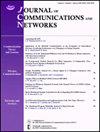血管中的生物纳米物联网:系统设计和原型
IF 2.9
3区 计算机科学
Q2 COMPUTER SCIENCE, INFORMATION SYSTEMS
引用次数: 0
摘要
在本文中,我们研究了生物物联网(IoBNT),它属于由分子通信形成的网络。通过提供一种通过无处不在的血管(动脉、静脉和毛细血管)进行通信的方式,基于分子通信的IoBNT实现了一系列新的eHealth应用。例如,器官监测传感器可以通过IoBNT将体内信号传输到健康监测应用程序。我们的经验表明,与自由空间通道相比,血管通道在分子通信系统的设计中引入了一系列新的挑战。然后,我们提出了圆柱形管道通道模型,并讨论了符合通道特性的相应系统设计。此外,基于原型实现,我们确认分子通信技术可以用于组成IoBNT。我们相信,这项工作中提出的有希望的结果,加上未来丰富的研究挑战,有力地表明IoBNT与分子通信可以推动新兴电子健康系统的新应用。本文章由计算机程序翻译,如有差异,请以英文原文为准。
The Internet of bio-nano things in blood vessels: System design and prototypes
In this paper, we investigate the Internet of bionano things (IoBNT) which pertains to networks formed by molecular communications. By providing a means of communication through the ubiquitously connected blood vessels (arteries, veins, and capillaries), molecular communication-based IoBNT enables a host of new eHealth applications. For example, an organ monitoring sensor can transfer internal body signals through the IoBNT to health-monitoring applications. We empirically show that blood vessel channels introduce a new set of challenges in the design of molecular communication systems in comparison to free-space channels. Then, we propose cylindrical duct channel models and discuss the corresponding system designs conforming to the channel characteristics. Furthermore, based on prototype implementations, we confirm that molecular communication techniques can be utilized for composing the IoBNT. We believe that the promising results presented in this work, together with the rich research challenges that lie ahead, are strong indicators that IoBNT with molecular communications can drive novel applications for emerging eHealth systems.
求助全文
通过发布文献求助,成功后即可免费获取论文全文。
去求助
来源期刊
CiteScore
6.60
自引率
5.60%
发文量
66
审稿时长
14.4 months
期刊介绍:
The JOURNAL OF COMMUNICATIONS AND NETWORKS is published six times per year, and is committed to publishing high-quality papers that advance the state-of-the-art and practical applications of communications and information networks. Theoretical research contributions presenting new techniques, concepts, or analyses, applied contributions reporting on experiences and experiments, and tutorial expositions of permanent reference value are welcome. The subjects covered by this journal include all topics in communication theory and techniques, communication systems, and information networks. COMMUNICATION THEORY AND SYSTEMS WIRELESS COMMUNICATIONS NETWORKS AND SERVICES.

 求助内容:
求助内容: 应助结果提醒方式:
应助结果提醒方式:


